Why in the apartment the hood is blowing in the opposite direction: the main reasons and ways to eliminate the back draft
If an extractor hood blows into an apartment in an apartment, then this immediately affects the comfort, and often the safety of living. And with this you need to do something. Do you agree? After all, nobody wants to breathe stale air, get sick with respiratory illnesses or be constantly threatened by a gas explosion.
Moreover, in some cases it is not difficult to solve the problem, and even on their own. And we’ll talk about how to do it right in our article - we will analyze the main reasons for which there is a reverse craving in the apartment, as well as provide recommendations for resolving the problem.
The content of the article:
Why does the ventilation system fail?
There are a lot of reasons for the occurrence of reverse draft, but they are always based on the same physical process, as a result of which higher pressure arises in the ventilation ducts than in the rooms. That does not allow moisture, odors and harmful substances to leave the building.
In addition, under the influence of high pressure, polluted air and steam is squeezed out of the ventilation system channels into all nearby openings. For example, in cracks, crevices of channels.
And the worst part is that the air from the high-pressure area for the most part falls precisely into the housing, since this is the easiest way.
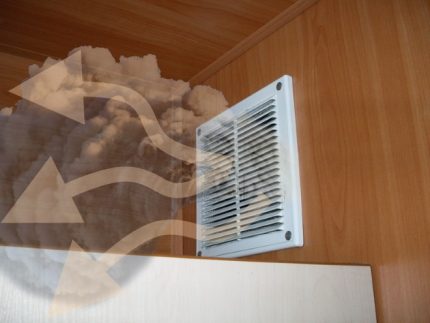
When the system works in the opposite direction and extracts odors, moisture does not occur from the room, then residents have to think about what to do to fix the problem.
And you can achieve the desired result by performing a series of procedures, which include:
- Visual inspection of the ventilation system;
- Checking the correct installation of ventilation system structural elements;
- Verification of design documentation.
At each stage, the performers are looking for the causes and places of occurrence of high pressure zones, which lead to the occurrence of reverse thrust.
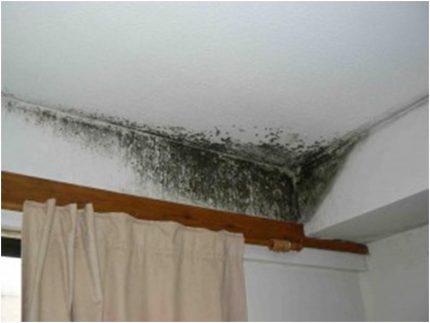
Since the problem of backdraft directly affects the comfort and quality of the microclimate in housing, it is necessary to get acquainted with the causes of its occurrence in more detail.
Reason # 1 - foreign objects in the ventilation duct
Any change in ventilation design can lead to a decrease in air exchange efficiency. And this often happens. But it simplifies the problem of troubleshooting that it can be done quickly and without any cost. Since all that is needed is a visual inspection, which, if desired, can be done by yourself.
But you should not abuse such an opportunity. Because at the same time, you should still have some skills, and most importantly, to know and follow safety measures.
When performing a visual inspection, pay attention to:
- channel status air ducts and other structural elements;
- duct design integrity and other parts of the system.
In the first case, the presence or absence of external objects in the ducts is detected. Which significantly affect the performance of the ventilation system.
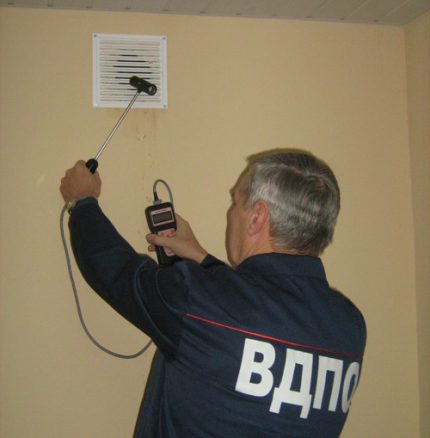
The reason is that when foreign objects get inside the channels, air exchange is disturbed, which in turn leads to the occurrence of reverse thrust.
And the worst thing is that almost any third-party item can create problems, including leaves, tree branches, soot, plastic bags, scraps of paper and any other garbage.
To get rid of garbage and other items that should not be in the ventilation duct, you need to perform cleaning.
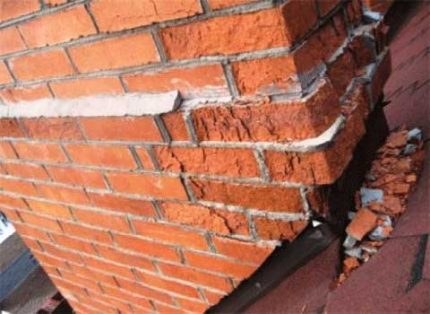
To reduce the likelihood of foreign objects entering the air ducts, moisture should be installed deflectors. They protect against wind, which can lead to reverse traction.
Reason # 2 - mechanical damage and wear
If inspection of the condition of the internal channels has not yielded results, then you should verify their integrity.
Why it is necessary to examine the elements of the system for the absence of:
- mechanical damage;
- traces of wear;
- traces of aging of the material from which the structural elements of ventilation are made.
Reverse thrust can occur due to mechanical damage such as the unauthorized appearance of additional holes in the walls of the ducts. An example is cutting down a seat for a fan.
Such a malfunction as reverse ventilation in the apartment may occur due to the fact that individual elements, due to wear and tear, degrade the performance of the ventilation system.For example, if the fan provided in the design is stuck, then a higher pressure zone may arise on the floor above, which air naturally discharged will not push.
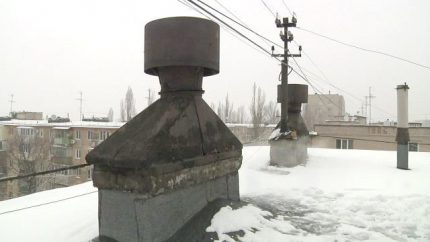
The above defects are eliminated by filling cracks, holes, replacing failed structural elements or cleaning them, which is true in relation to fans, baffles and other equipment.
Reason # 3 - difficult climatic conditions
Often, difficult climatic conditions lead to partial or complete blocking of ducts. For example, fog, severe frost or wind, precipitation.
The reason is that at a negative temperature on the inner surfaces of the channels ice layers can occur, and significant ones. As a result, the natural air exchange procedure can be disturbed for a long time.
With strong winds, fogs, precipitation, reverse thrust can occur for a short time. But, nevertheless, this still leads to a decrease in the level of comfort and safety in housing.
The only effective way to eliminate the problem of ice build-up in the ventilation ducts is through cleaning.
Reason # 4 - installation errors
It often happens that poor-quality or improper installation significantly affects the parameters of the ventilation system. For example, to provoke the appearance of a zone of high pressure, and, consequently, reverse thrust, an air duct or its leaky joints can be installed at an incorrect angle.
Incorrectly installed deflectors, tips, fans, gratingsvalve.
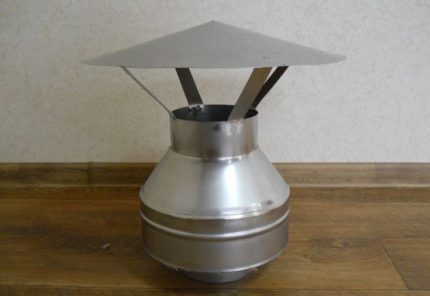
Problems are eliminated with the help of high-quality installation of structural elements.
Reason # 5 - ignoring project documentation
It almost always happens that some experts design, while others perform installation, while many standards are only advisory in nature. As a result, it often happens as in the famous fable about the swan, cancer and pike.
Therefore, an improperly installed deflector or ventilation duct of an inappropriate size leads to the appearance of pressure zones.
Problems can create:
- heads of the wrong length;
- air ducts, the cross section of which differs from the design;
- fans whose performance exceeds design and more.
Moreover, the listed reasons are easy to identify, but there are many options that only specialists can figure out.
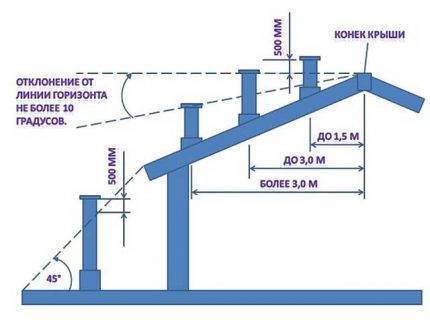
For example, this can happen if:
- the volume of the ventilation duct or its internal design does not meet the requirements;
- the dimensions of the sections of channels, pipes, hoods, heads do not allow to cope with the removal of the required volume of air;
- more consumers than planned;
- in ducts inappropriate temperature and so on.
Reconciliation with project documentation is the most difficult way to identify the causes of reverse thrust. But in this case, it is necessary to have a substantial supply of knowledge and skills, since it is often necessary to carry out control and verification procedures.
System performance is restored by replacing structural elements that do not match the design.
And, when this is not possible, methods such as:
- sleeve, which is the placement of thin-walled pipes inside the ventilation shaft that can change the characteristics of the system as a whole;
- extension of the length of the ventilation pipe.
The last way to eliminate reverse thrust is one of the most effective, and in most situations.
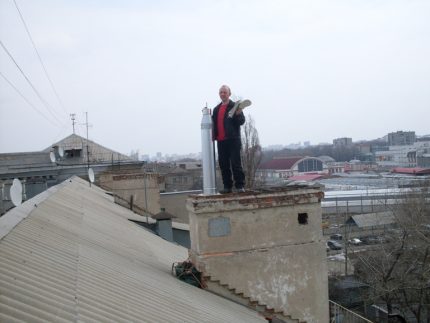
So, an extension of only 1 meter can eliminate the likelihood of a recurrence of reverse thrust in a number of situations. Moreover, in many cases it will not be necessary to eliminate the shortcomings that led to the problem.
Why is reverse thrust still occurring?
In the previous part of the article, the traditional causes of malfunctions in the ventilation system were listed. They manifest and will manifest themselves while people use air ducts. As a result, effective technologies have long been worked out that allow you to quickly and without any cost to restore the performance of any ventilation system.
But in the past few decades, technologies that require an integrated approach and the participation of all residents have begun to be actively used in our country. And there are regularly problems with this.

Therefore, the residents of many houses are not able to cope with a number of reasons leading to reverse traction:
- mass installation of modern airtight windows;
- the appearance of a high pressure area above the upper floors due to significant loads on the system;
- inconsistency of actions and illiteracy of residents.
Since the ventilation systems of a significant number of multi-storey buildings are ineffective due to the listed reasons, each of them should be examined in more detail.
Replacing old windows with plastic
Before you take up the restoration of ventilation, it should be understood that in most modern homes it is based on the principles of natural air exchange.
This means that a so-called slot air flow must exist. Moreover, most of it should enter the housing through windows, but modern metal-plastic models are airtight. That is, they do not have gaps and inflow is not carried out.
At the same time, the hood has not been canceled, and it removes air with the intended performance. But until the moment when the pressure in the room drops below a similar parameter in the duct, which will lead to the appearance of reverse thrust.
And the worst thing is that it will not work to restore normal air exchange, and none of the methods listed in the first part of the article will work out until the windows are closed. But in many cases, to restore normal air exchange, it is enough to keep the windows ajar. That is, nothing more will need to be done.
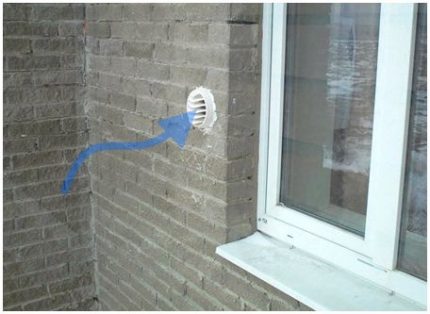
But since airing is not always possible, it is better to use:
- air inlets to the wall (wall);
- window valves for the organization of slit micro-ventilation.
It should be borne in mind that in many cases the efficiency of the ventilation system can be returned if the majority of users install the supply valves. And it can be difficult to convince people of this.
If the above solutions are unacceptable, you can drill one hole in the area of the entrance door to the entrance, and the second, with a diameter of 1 cm, above the entrance door to the housing. And this method is often enough to get rid of the reverse thrust forever. The fact is that stairwells are usually the most powerful hoods in homes. But the described option is suitable only when they do not smoke in the porches. But, if this is not so, then a different solution should be sought.
Insufficient ventilation box height on the upper floors
Natural ventilation is effective when air particles can move vertically at least 2 meters. And homeowners on the penultimate and lower floors were lucky. Since there is enough margin of distance in their ventilation systems.
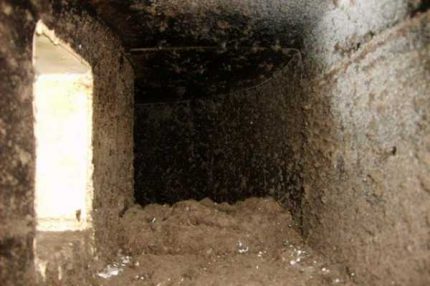
But above each last floor there is a horizontal ventilation duct or a warm technical floor. As a result, in the first case, the air flow is inhibited to block the duct and immediately an increased pressure zone is created. Therefore, part of the air returns and enters the ventilation hoods of the upper floors, as this is the easiest way.
The situation is aggravated by the fact that hoods and fans are increasingly being used. Moreover, a mixture of vapors and odors from all floors gets into housing.
To deal with this situation, you can increase the height of the horizontal ventilation boxes (2-3 times), install devices in them called "dissection".
But the opportunity to use the above methods is not always provided. Therefore, to solve the problem, sometimes it is necessary to create an individual channel, which cuts into the shaft on top of common boxes.
But this procedure is called redevelopment, and the duct to which you need to connect is a common house property. As a result, it is necessary to obtain the consent of all neighbors (which is not always easy) and go through the approval procedure in the housing inspection.
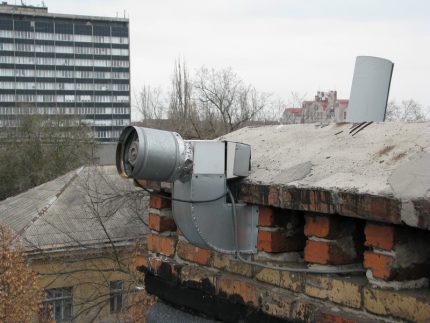
In the case of warm technical floors, the polluted air from the apartment on the top floor simply slows down. Still, traction provides the system with efficiency. But in the presence of cracks, cracks or open doors from the technical floor, it overturns and the polluted air goes to the apartments of the upper floors.
In this case, create your own individual channel, which should be lengthened and slightly tilted towards the common shaft. But, again, all of the above can be done only after obtaining permission from the neighbors and completing the approval procedure.
Reluctance of tenants to act together
But it should be remembered that ventilation is a common system for the entire entrance. And if one of the residents installed a too powerful exhaust hood, and you suffer from the fact that the ventilation system can’t cope and the exhaust air not only comes back, but also odors also enter the apartment, then you need to act together. First, in the event of a back draft, you should discuss this problem with other residents of the entrance. Since in many cases this trouble is common to all users.
After that, it is worthwhile to collectively turn to the management company with a request to solve the problem comprehensively. Moreover, the described method of dealing with reverse thrust is the most effective.
But, unfortunately, in many cases a problem arises with the organization. Since in critical situations, many residents prefer to solve problems in easier and faster ways (as they think).For example, installing air conditioning systems, recovery. And without even realizing that it is impossible to replace natural ventilation with anything, especially this applies to houses where there is gas.

And if unpleasant cold and musty air blows from the ventilation, and the neighbors do not want to deal with this, then you can call on Gorgaz to help yourself. For example, exhausting their specialists with complaints of violation security measuresif there is a distinct smell of gas in the room. But this happens quite often - the reverse draft does not allow ventilating the room, both from the energy carrier and from its combustion products (for example, carbon monoxide).
By the way, if in the house even sometimes there is a reverse draft, then at least part of the windows should be replaced with those that are destroyed when gas explosion - anti-explosive. Which will reduce the likelihood of a severe outcome.
But the problem of backdraft is relevant not only for residents of high-rise buildings, but also for the private sector. Common causes of its occurrence and their elimination we examined in next article.
Conclusions and useful video on the topic
The first video shows a problem with ventilation due to sealed windows:
The following video helps you understand how you can independently resolve the reverse thrust problem:
Return draft in the ventilation system is an unpleasant and very common phenomenon. And the inhabitants of thousands of Russian high-rise buildings suffer from it. Nevertheless, it is possible to normalize the air exchange, although in most cases this will require the interest of all or at least the majority of the residents of the entrance.
The problem of backdraft is familiar to you firsthand and you want to talk about how you managed to get rid of it? Or would you like to supplement the above material with useful information? Write your comments, share experiences, participate in the discussion - the feedback block is located below this publication.

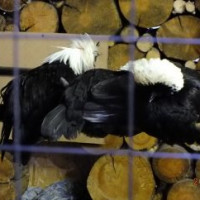 Hood in the chicken house: the best ways to equip the ventilation system in the house
Hood in the chicken house: the best ways to equip the ventilation system in the house 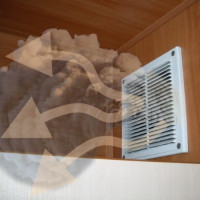 Return draft ventilation in a private house: common causes and their elimination
Return draft ventilation in a private house: common causes and their elimination 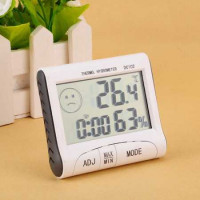 Norm of air humidity in the apartment: measurement methods + tips for normalization
Norm of air humidity in the apartment: measurement methods + tips for normalization 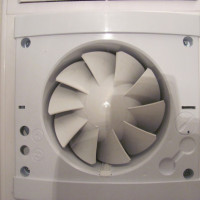 Hood for bathroom and toilet: the subtleties of creating a project and the nuances of arranging the system
Hood for bathroom and toilet: the subtleties of creating a project and the nuances of arranging the system 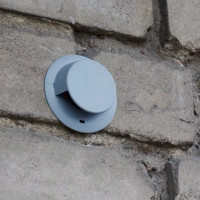 Ventilation in a private house from aerated concrete: options and methods of construction
Ventilation in a private house from aerated concrete: options and methods of construction 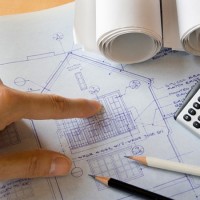 Calculation of air ducts for speed and flow rate + methods for measuring air flow in rooms
Calculation of air ducts for speed and flow rate + methods for measuring air flow in rooms  How much does it cost to connect gas to a private house: the price of organizing gas supply
How much does it cost to connect gas to a private house: the price of organizing gas supply  The best washing machines with dryer: model rating and customer tips
The best washing machines with dryer: model rating and customer tips  What is the color temperature of light and the nuances of choosing the temperature of the lamps to suit your needs
What is the color temperature of light and the nuances of choosing the temperature of the lamps to suit your needs  Replacement of a geyser in an apartment: replacement paperwork + basic norms and requirements
Replacement of a geyser in an apartment: replacement paperwork + basic norms and requirements